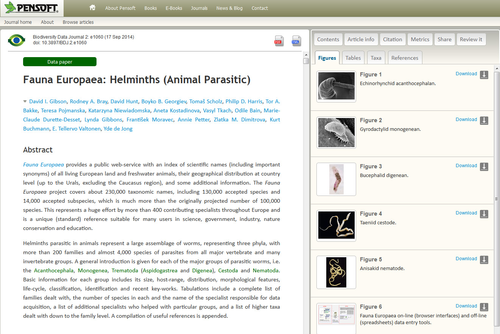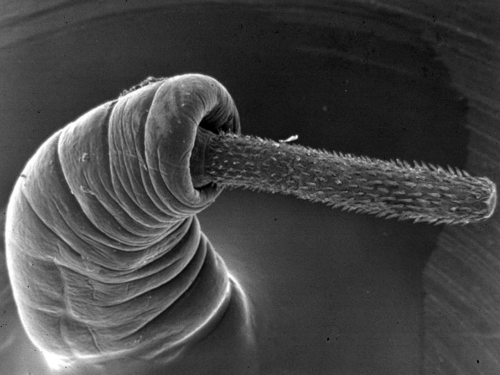

Fauna Europaea started in 2000 as an EC-FP5 four-year project, delivering its first release in 2004. After 14 years of steady progress and successful participations in several EC projects, as a part of the EC-FP7 European Biodiversity Observation Network project (EU BON), to increase the general awareness of the work done by the contributors and to extend the general dissemination of the Fauna Europaea results, the Biodiversity Data Journal has applied its novel e-Publishing tools to prepare data papers for all 56 major taxonomic groups.
Fauna Europaea provides a public web-service with an index of scientific names (including important synonyms) of all living European land and freshwater animals, their geographical distribution at country level, and some additional information. The Fauna Europaea project covers about 230,000 taxonomic names, including 130,000 species name. This represents a huge effort by more than 400 contributing specialists throughout Europe and is a unique (standard) reference suitable for many users in science, government, industry, nature conservation and education.
'Contributio ns on Fauna Europaea' is the second series launched by the Biodiversity Data Journal after the Checklist of British and Irish Hymenoptera and the first one that embraces thematic data-papers structured in a common pattern extracted from a large database. This novel publication model will assemble in a single-issue 56 data-papers on different taxonomic groups covered by the Fauna Europaea project in the period 2000-2014 and a range of accompanying papers highlighting various aspects of this project (gap-analysis, software design, taxonomic assessments, etc.).
ns on Fauna Europaea' is the second series launched by the Biodiversity Data Journal after the Checklist of British and Irish Hymenoptera and the first one that embraces thematic data-papers structured in a common pattern extracted from a large database. This novel publication model will assemble in a single-issue 56 data-papers on different taxonomic groups covered by the Fauna Europaea project in the period 2000-2014 and a range of accompanying papers highlighting various aspects of this project (gap-analysis, software design, taxonomic assessments, etc.).
This is the first collection of data-papers of this scale. It will formalise and effectively publish the results of nearly 500 contributors building the largest European animal (taxonomic) database. The new publication model provides a reliable mechanism for citation and bibliographic indexing of large and uniformly structured databases.
"The publication of Fauna Europaea data papers brings a number of benefits for science, for example it stimulates experts to hand-over descriptive details on their groups, triggers new ways of community networking and participation, motivates experts to update their data, supports a better documentation of their achievements, including issues like 'micro-publications', and increase an ownership feeling with the associated effort" said Dr Yde de Jong, coordinator of the Fauna Europaea and Pan-European Species directories Infrastructure (PESI) projects.
 The launch of this large collection of data papers coincides with one more cutting-edge innovation of the Biodiversity Data Journal, the publication of an API, a first of its kind, to import complex and data-rich manuscripts, which include text, data, images, in-text citations, references, in fact anything that a manuscript may contain.
The launch of this large collection of data papers coincides with one more cutting-edge innovation of the Biodiversity Data Journal, the publication of an API, a first of its kind, to import complex and data-rich manuscripts, which include text, data, images, in-text citations, references, in fact anything that a manuscript may contain.
"I am happy that these exciting innovations coincided with the first birthday of the Biodiversity Data Journal. Just a year ago we launched this new concept with the motto: Making your data count! These novel approaches and tools are an excellent example how our concept evolved!" comments Prof. Lyubomir Penev, Managing Director of Pensoft Publishers.
Original Sources:
de Jong Y, Verbeek M, Michelsen V, Bjørn P, Los W, Steeman F, Bailly N, Basire C, Chylarecki P, Stloukal E, Hagedorn G, Wetzel F, Glöckler F, Kroupa A, Korb G, Hoffmann A, Häuser C, Kohlbecker A, Müller A, Güntsch A, Stoev P, Penev L (2014) Fauna Europaea – all European animal species on the web. Biodiversity Data Journal 2: e4034. doi: 10.3897/BDJ.2.e4034
Gibson D, Bray R, Hunt D, Georgiev B, Scholz T, Harris P, Bakke T, Pojmanska T, Niewiadomska K, Kostadinova A, Tkach V, Bain O, Durette-Desset M, Gibbons L, Moravec F, Petter A, Dimitrova Z, Buchmann K, Valtonen E, de Jong Y (2014) Fauna Europaea: Helminths (Animal Parasitic). Biodiversity Data Journal 2: e1060. doi: 10.3897/BDJ.2.e1060




 RSS news
RSS news Print this article
Print this article
